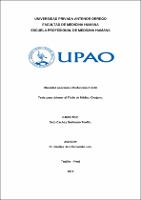Obesidad asociada a disfunción eréctil

View/
Download
(application/pdf: 111.1Kb)
(application/pdf: 111.1Kb)
Date
2019Author(s)
Soto Cachay, Guillermo Teófilo
Metadata
Show full item recordAbstract
Objetivo: Evaluar si la obesidad está asociada a la disfunción eréctil(ED).
Material y métodos: Se inició un estudio observacional de corte transversal donde se incluyeron a 189 pacientes nuevos que acudieron al servicio de Urología del Hospital Belén de Trujillo durante el periodo Mayo-junio 2019; según criterios de selección se dividió a pacientes con/sin obesidad a los cuales se les evaluó si presentaban o no ED; donde se aplicó la RP (razón de prevalencia), Prueba exacta de Fisher y la prueba estadística chi cuadrado.
Resultados: La ED en obesos es del 97,96% y en no obesos del 97,80%, con una RP (intervalo de confianza (IC95%)): 1,002 (0,960-1,045). Además, se evaluó las variables intervinientes asociadas a ED, donde la única variable asociada es la edad; los pacientes con ED estaban en los años 66,08 ± 10,83 y los que no tenían ED estaban en los años 55,00 ± 13,54 con un p: 0,045. Las variables de HTA, DM tipo 2, Dislipidemias (HDL Y triglicéridos), CC (Circunferencia de cintura) y consumo de tabaco no tuvieron asociación con la ED; concluyendo que la obesidad no está asociada a la ED. Esta no asociación es corroborada con la prueba Exacta de Fisher por tener un valor de (p de Prueba Exacta de Fisher =0,661) mayor a 0,05.
Conclusión: La obesidad no es un factor asociado a la ED. Objective: To assess whether obesity is associated with erectile dysfunction (ED).
Material and methods: An observational cross-sectional study was initiated, including 189 new patients who attended the Urology department of the Belén de Trujillo Hospital during the May-June 2019 period; according to selection criteria, patients with / without obesity were divided and evaluated whether or not they had ED; where the RP (prevalence ratio), Fisher's exact test and the chi-square statistical test were applied.
Results: The ED in obese is 97.96% and in non-obese 97.80%, with a PR (confidence interval (95% CI)): 1.002 (0.960-1.045). In addition, the intervening variables associated with ED were evaluated, where the only associated variable is age; patients with ED were in the years 66.08 ± 10.83 and those without ED were in the years 55.00 ± 13.54 with a p: 0.045. The variables of HTA, type 2 DM, dyslipidemias (HDL and triglycerides), CC (waist circumference) and tobacco consumption had no association with ED; concluding that obesity is not associated with ED. This non-association is corroborated by Fisher's Exact test because it has a value of (p Fisher's Exact Test = 0.611) greater than 0.05.
Conclusion: Obesity is not a factor associated with ED.
Collections
- Medicina Humana [2969]

